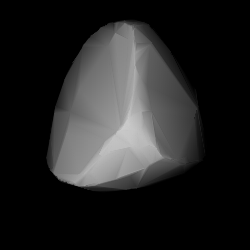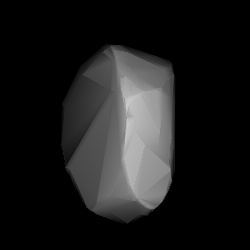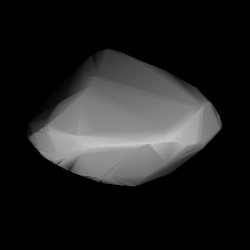
1743 Schmidt, provisional designation 4109 P-L, is a dark background asteroid from the inner regions of the asteroid belt, approximately 19 kilometers in diameter. It was discovered during the Palomar–Leiden survey on 24 September 1960, by astronomers Ingrid and Cornelis van Houten at Leiden, on photographic plates taken by Tom Gehrels at Palomar Observatory in California. The C-type asteroid has a rotation period of 17.5 hours. It was named for the optician Bernhard Schmidt.
1853 McElroy, provisional designation 1957 XE, is an asteroid from the outer region of the asteroid belt, approximately 21 kilometers in diameter. It was discovered on 15 December 1957, by the Indiana Asteroid Program at Goethe Link Observatory near Brooklyn, Indiana, United States, and named for American biochemist William D. McElroy.

1042 Amazone, provisional designation 1925 HA, is a dark asteroid and slow rotator in the outer asteroid belt, approximately 70 kilometers in diameter. It was discovered on 22 April 1925, by German astronomer Karl Reinmuth at Heidelberg Observatory in southern Germany. It is named after the Amazons from Greek mythology.
1092 Lilium, provisional designation 1924 PN, is a dark, carbonaceous background asteroid from the outer regions of the asteroid belt, approximately 44 kilometers in diameter. It was discovered on 12 January 1924, by German astronomer Karl Reinmuth at the Heidelberg Observatory in southwest Germany. The asteroid was named after the flower Lilium.

1118 Hanskya is a large background asteroid, approximately 77 kilometers in diameter, located in the outer regions of the asteroid belt. Discovered by Sergey Belyavsky and Nikolaj Ivanov in 1927, it was named after Russian astronomer Aleksey Hansky. The presumed dark C-type asteroid has a rotation period of 15.6 hours.
1567 Alikoski, provisional designation 1941 HN, is a rare-type carbonaceous asteroid from the outer region of the asteroid belt, approximately 67 kilometers in diameter. It was discovered on 22 April 1941, by Finnish astronomer Yrjö Väisälä at Turku Observatory in Southwest Finland. It was later named after Finnish astronomer Heikki Alikoski.
1295 Deflotte, provisional designation 1933 WD, is a carbonaceous asteroid from the outer regions of the asteroid belt, approximately 48 kilometers in diameter. It was discovered on 25 November 1933, by French astronomer Louis Boyer at the Algiers Observatory in Algeria, North Africa. The asteroid was named after the discoverer's nephew.

1328 Devota, provisional designation 1925 UA, is a dark background asteroid from the outermost regions of the asteroid belt, approximately 56 kilometers in diameter. It was discovered on 21 October 1925, by Russian–French astronomer Benjamin Jekhowsky at the Algiers Observatory in North Africa. The asteroid was named after Argentine astronomer Fortunato Devoto.
1250 Galanthus, provisional designation 1933 BD, is a dark background asteroid from the central regions of the asteroid belt, approximately 20 kilometers in diameter. It was discovered on 25 January 1933, by German astronomer Karl Reinmuth at the Heidelberg Observatory. The asteroid was named for the herbaceous plant Galanthus, also known as "snowdrop".
1524 Joensuu, provisional designation 1939 SB, is a carbonaceous asteroid from the outer region of the asteroid belt, approximately 42 kilometers in diameter. It was discovered on 18 September 1939, by Finnish astronomer Yrjö Väisälä at Turku Observatory in Southwest Finland, and named for the town of Joensuu.
1504 Lappeenranta, provisional designation 1939 FM, is a stony background asteroid from the inner regions of the asteroid belt, approximately 12 kilometers in diameter. It was discovered on 23 March 1939, by Finnish astronomer Liisi Oterma at the Iso-Heikkilä Observatory, and named after the city of Lappeenranta in Finland.
1303 Luthera, provisional designation 1928 FP, is a dark asteroid and the parent body of the Luthera family, located in the outermost regions of the asteroid belt. It measures approximately 90 kilometers in diameter. The asteroid was discovered on 16 March 1928, by astronomer Friedrich Schwassmann at the Bergedorf Observatory in Hamburg, Germany, and later named after German astronomer Robert Luther.
1760 Sandra, provisional designation 1950 GB, is a carbonaceous asteroid from the outer regions of the asteroid belt, approximately 35 kilometers in diameter. It was discovered on 10 April 1950, by South African astronomer Ernest Johnson at Union Observatory in Johannesburg, and named after his granddaughter Sandra.

2111 Tselina is a stony Eos asteroid from the outer regions of the asteroid belt. It was discovered on 13 June 1969, by Soviet astronomer Tamara Smirnova at Crimean Astrophysical Observatory in Nauchnij, on the Crimean peninsula. The S-type asteroid has a rotation period of 6.6 hours and measures approximately 23 kilometers in diameter. It was later named after the Soviet Virgin Lands Campaign.
1323 Tugela, provisional designation 1934 LD, is a dark background asteroid from the outer regions of the asteroid belt, approximately 60 kilometers in diameter. It was discovered on 19 May 1934, by South African astronomer Cyril Jackson at the Union Observatory in Johannesburg. The asteroid was named for the Tugela River in western South Africa.

1186 Turnera, provisional designation 1929 PL, is a stony Eoan asteroid from the outer regions of the asteroid belt, approximately 36 kilometers in diameter. It was discovered on 1 August 1929, by South African astronomer Cyril Jackson at the Union Observatory in Johannesburg. The asteroid was later named after British astronomer Herbert Hall Turner.

2120 Tyumenia is a dark background asteroid, approximately 45 kilometers in diameter, located in the outer regions of the asteroid belt. It was discovered on 9 September 1967, by Soviet astronomer Tamara Smirnova at the Crimean Astrophysical Observatory in Nauchnyj, on the Crimean peninsula. The asteroid was named for the now Russian district of Tyumen Oblast in Western Siberia.

1940 Whipple is a carbonaceous background asteroid from the outer region of the asteroid belt, approximately 35 kilometers in diameter. It was discovered on 2 February 1975, by the Harvard College Observatory at its George R. Agassiz Station near Harvard, Massachusetts, in the United States, and named after astronomer Fred Whipple.

1336 Zeelandia, provisional designation 1934 RW, is a stony Koronian asteroid from the outer regions of the asteroid belt, approximately 21 kilometers in diameter. It was discovered on 9 September 1934, by Dutch astronomer Hendrik van Gent at the Union Observatory in Johannesburg, South Africa. The asteroid was named for the Dutch province of Zeeland.
1461 Jean-Jacques, provisional designation 1937 YL, is a metallic asteroid from the outer region of the asteroid belt, approximately 34 kilometers in diameter. It was discovered on 30 December 1937, by French astronomer Marguerite Laugier at Nice Observatory in southern France, who named it after her son Jean-Jacques Laugier.









